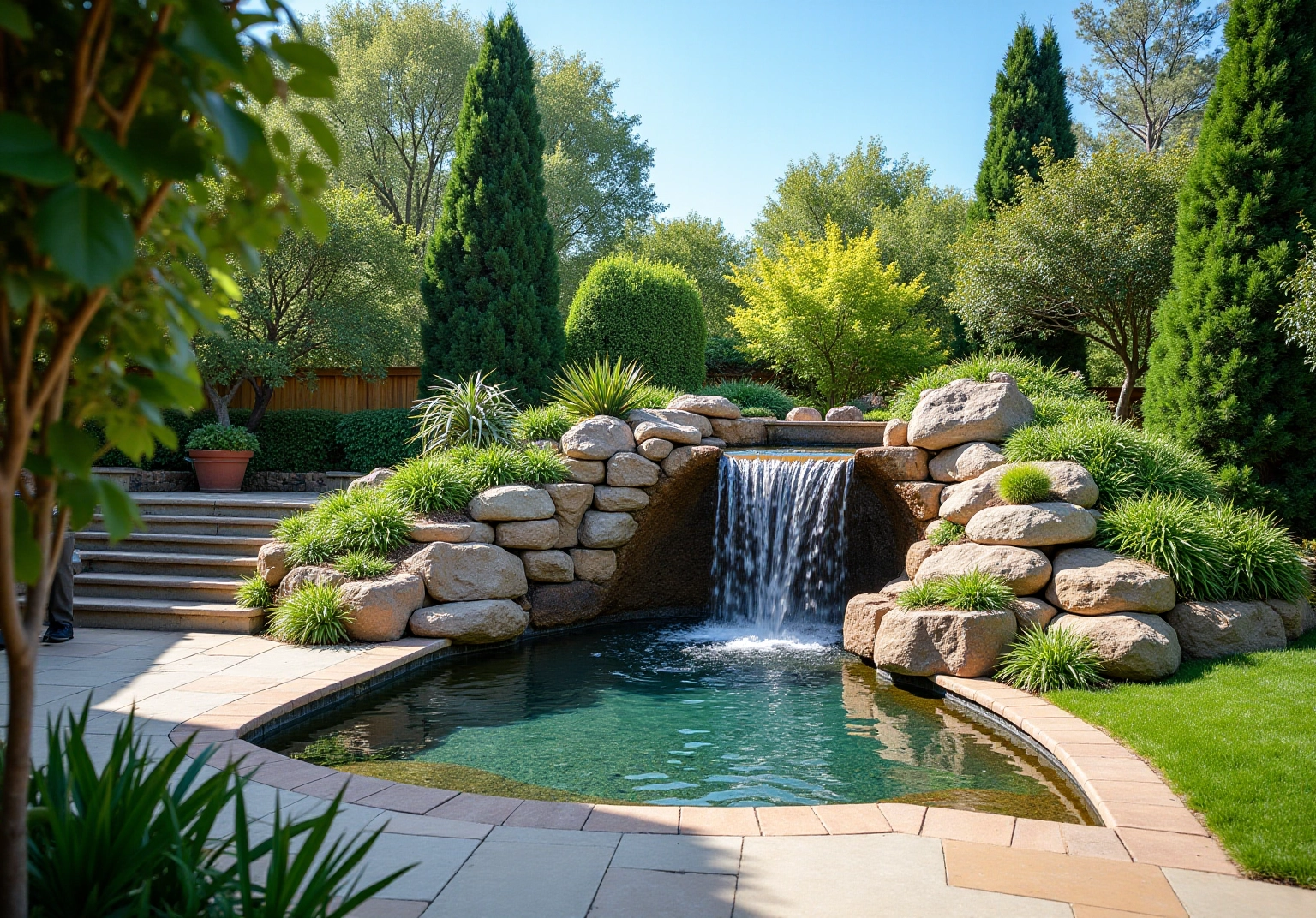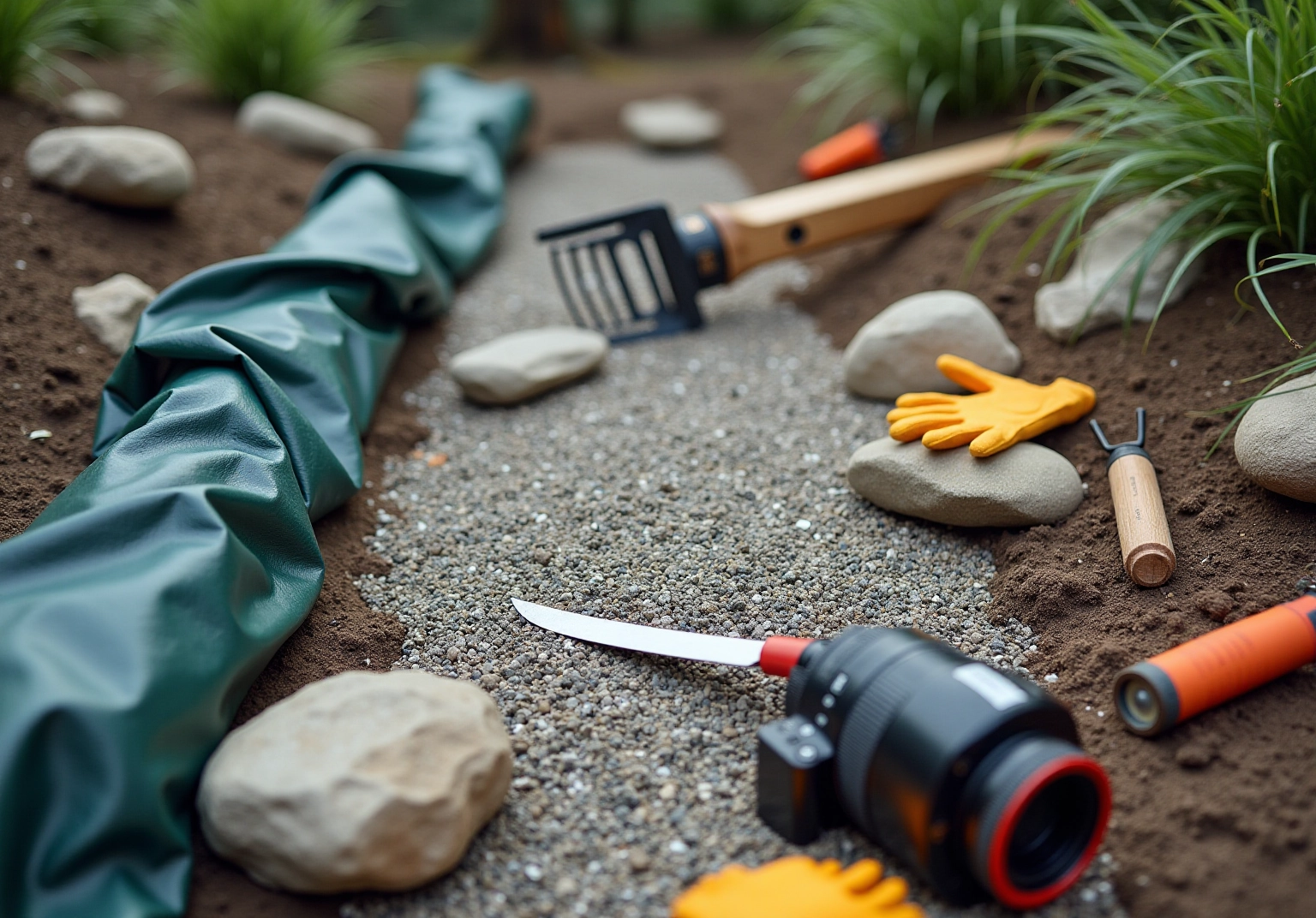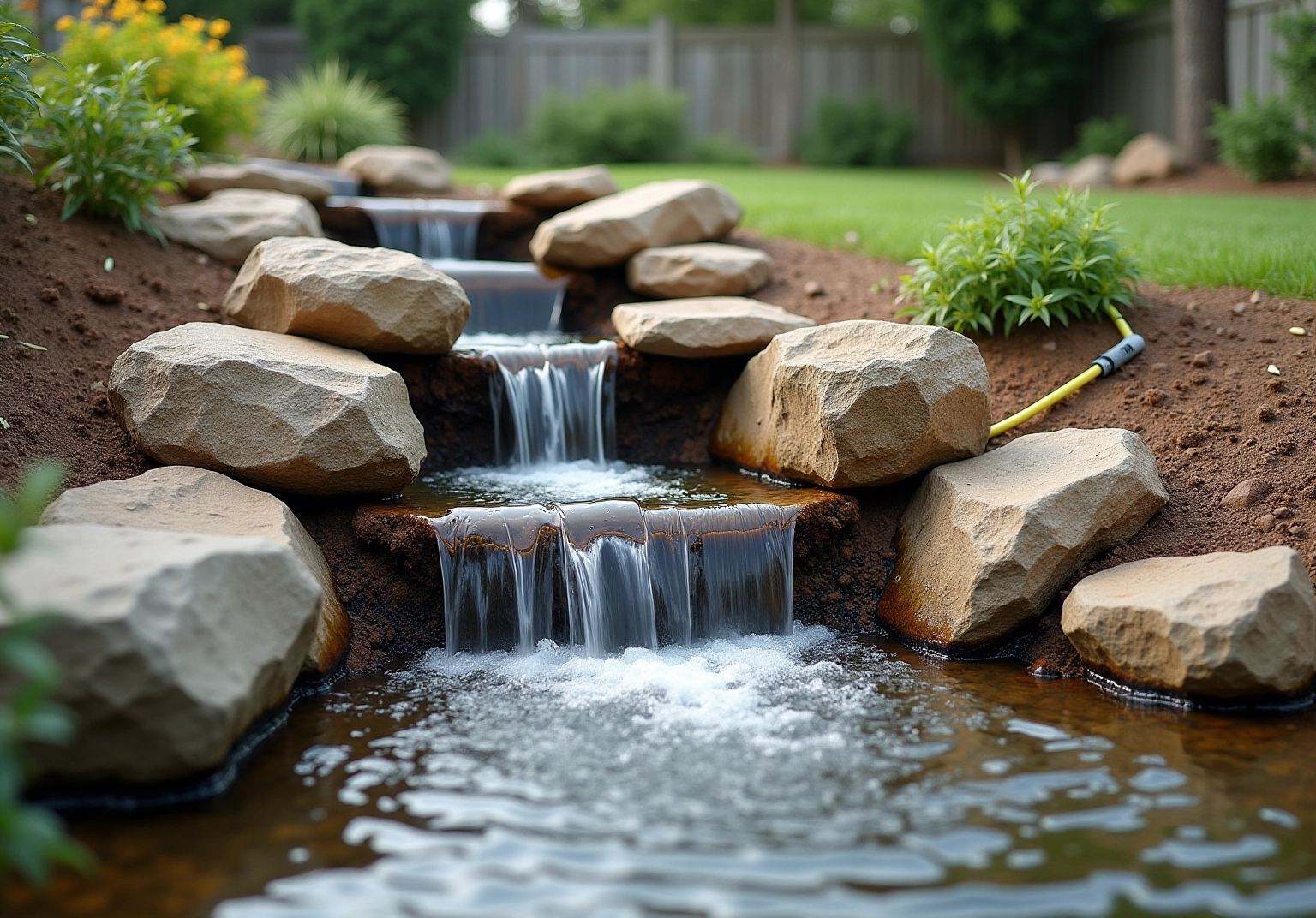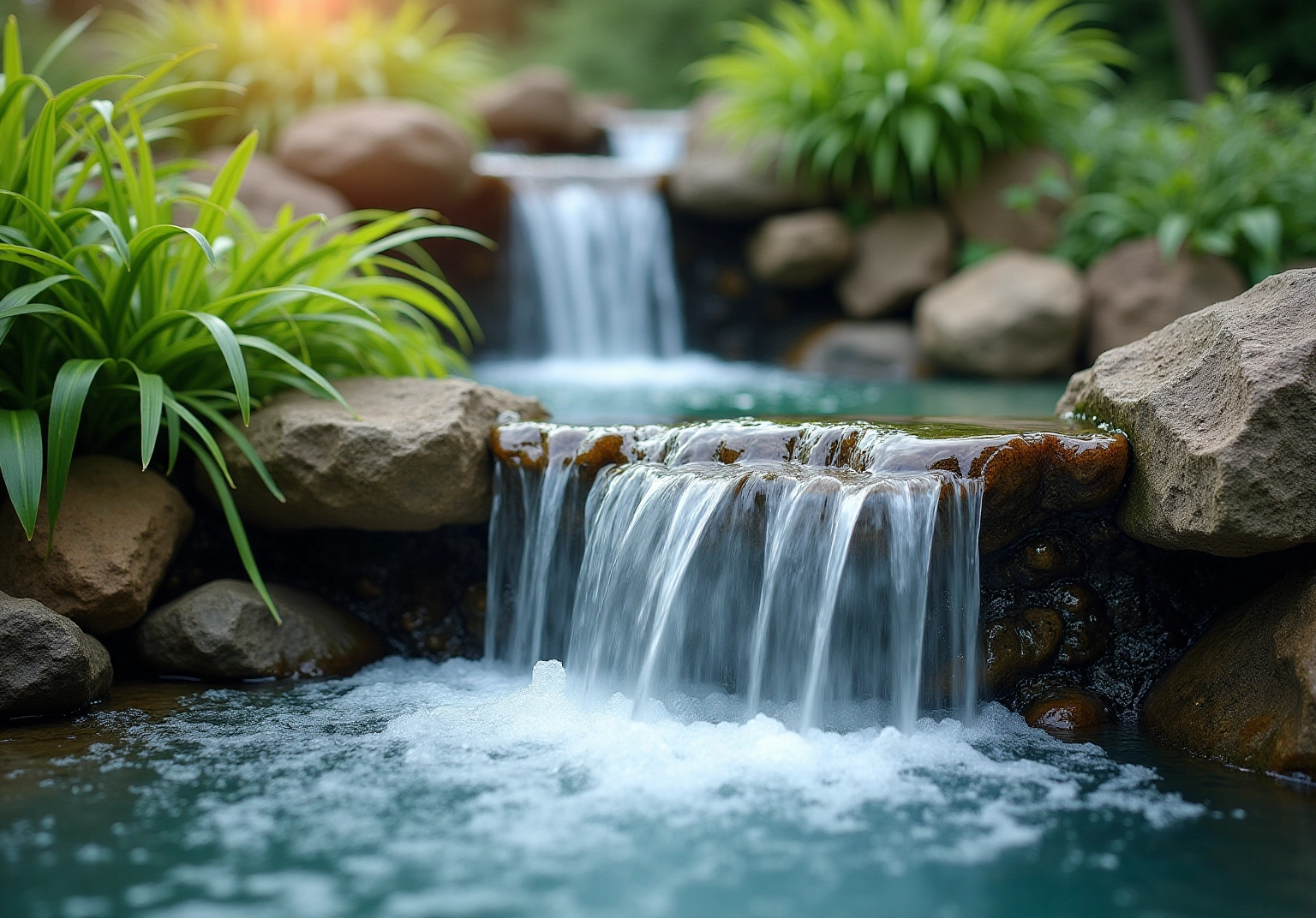Overview
Creating a stunning waterfall in your garden requires careful planning, the selection of appropriate materials, and adherence to a step-by-step construction process. This article offers clear guidance on:
- Envisioning your design
- Gathering the necessary tools and materials
- Maintaining the feature
It emphasizes that thoughtful execution and regular upkeep are essential for ensuring the waterfall remains a beautiful focal point in your outdoor space. By following these principles, you can create a reliable and enduring addition to your garden.
Introduction
Creating a stunning garden waterfall can transform an ordinary outdoor space into a serene oasis, inviting relaxation and a deeper connection with nature. This guide explores the essential steps for designing, constructing, and maintaining a captivating water feature. Such a feature not only enhances the aesthetic appeal of a garden but also serves as a soothing backdrop for outdoor gatherings.
From envisioning the perfect waterfall style to gathering the right materials and executing a flawless build, every detail plays a crucial role in achieving a breathtaking result. With thoughtful planning and diligent upkeep, a garden waterfall can become a cherished focal point, dedicated to quality and bringing joy for years to come.
Define Your Vision and Plan Your Waterfall
Begin by envisioning the waterfall in garden you wish to create, considering several key aspects.
Style: Choose from a natural-looking cascade, a sleek modern design, or a tiered stream. Draw inspiration from nature or explore online resources to find a style that resonates with your vision.
Location: Identify a spot that enhances your garden’s overall aesthetics. Ensure the stream is visible from important viewpoints, such as patios or windows, while also considering sunlight exposure and proximity to existing plants.
Size: Determine the dimensions of your cascade. A larger cascade can serve as a striking focal point, whereas a smaller design may be more suitable for compact spaces, allowing for harmonious integration into the landscape.
Functionality: Consider the waterfall’s purpose. Will it serve purely as a decorative feature, or will it also play a functional role, such as aerating a pond or providing a habitat for local wildlife? A waterfall in garden, when thoughtfully designed, can establish a dynamic, refreshing quality in your outdoor space, enhancing the sensory experience and connection with nature.
Sketch Your Ideas: Create a rough sketch of your cascade design, including dimensions and specific features. This visual representation will aid in the planning process and assist in selecting suitable materials.
As you articulate your vision, reflect on how your feature can enhance other outdoor components, such as comfortable fire pits and custom shade structures, to foster an inviting and immersive atmosphere for relaxation and social interaction. By thoughtfully considering these elements, you can create a stunning feature like a waterfall in garden that transforms your garden into a serene retreat.

Gather Essential Materials and Tools
Before embarking on your waterfall project, gathering the right materials and tools is crucial for ensuring a successful build. Here’s what you’ll need:
-
Materials:
- Pond liner: Essential for retaining water and preventing leaks, with thicknesses typically ranging from 100 to 250 microns for optimal durability. Due to strict government regulations concerning conservation, the demand for pond liners, particularly in waste management applications, has increased. Therefore, selecting high-quality options is essential.
- Rocks and boulders: Choose a variety of sizes to create a natural and aesthetically pleasing appearance.
- Gravel: Important for drainage and providing stability to the structure.
- Pump: A high-quality submersible pump is essential for effectively circulating liquid, ensuring a consistent flow over the cascade.
- Tubing: Used to connect the pump to the cascade, allowing for smooth fluid movement.
- Cascade spillway: This element is essential for producing the desired cascade effect, guiding water flow elegantly.
- Optional: Consider adding decorative elements such as aquatic plants or ambient lighting to enhance the visual appeal of your feature. Common materials for these elements include natural stones and LED lights, which can create a stunning ambiance.
-
Tools:
- Shovel: For digging and shaping the area where the waterfall will be constructed.
- Level: To ensure that the cascade is even and flows correctly.
- Garden hose: Useful for marking the layout of your feature, helping visualize the design before digging.
- Utility knife: Necessary for cutting the pond liner to fit your specific design.
- Wheelbarrow: Ideal for transporting materials to and from the construction site.
- Safety gear: Always wear gloves and goggles to protect yourself during the building process.
As noted by Team Eternity Insights, “We really appreciate their hard work and are very happy to extend long-term business relations,” emphasizing the importance of quality materials and relationships in landscaping projects. By thoughtfully choosing these materials and tools, you can construct a beautiful water feature that enhances your garden’s charm and serenity.

Construct Your Waterfall: Step-by-Step Instructions
To create a stunning waterfall in your garden, follow these detailed steps:
- Mark the Area: Use a garden hose to outline the desired shape of your waterfall on the ground. This visual guide will assist you throughout the construction process.
- Excavate the Site: Dig out the marked area, ensuring it is deep enough to accommodate the liner and rocks. The depth should ideally allow for about 8 inches of rock facing to create a natural look.
- Install the Liner: Place the liner in the excavated area, ensuring it covers the entire space. Secure it in place with rocks or soil to prevent shifting.
- Create the Waterfall Structure: Begin by placing larger boulders at the base, gradually adding smaller rocks as you build upwards. Ensure the rocks are stable and arranged to facilitate a natural stream flow.
- Set Up the Pump: Position the pump in the water feature area and connect it to the tubing leading to the waterfall spillway. Ensure the pump is submerged and securely in place for optimal performance. Efficient setup of pumps and filters is essential for preserving the well-being of your aquatic feature.
- Test the Water Flow: Fill the pond with water and activate the pump to test the flow. Modify the rocks as needed to create your preferred cascading water effect, ensuring a harmonious and natural appearance.
- Finalize the Design: Enhance the overall appearance of your fountain by adding decorative elements such as plants, lighting, or additional landscaping features. Thoughtful integration of these finishing touches, as highlighted in the case study “Incorporating Finishing Touches,” can significantly elevate the aesthetic appeal of your water feature. Remember, as landscaping specialist David Beaulieu suggests, when undertaking projects such as constructing natural rock features, always keep home safety tips in mind.
By following these steps, you can successfully create a beautiful feature like a waterfall in your garden that not only enhances your garden but also provides a serene outdoor retreat.

Maintain Your Waterfall for Long-Lasting Beauty
To maintain the beauty and functionality of your waterfall, it is essential to adhere to these maintenance tips:
- Regular Cleaning: Routinely remove debris such as leaves and dirt from both the waterfall and water feature areas. This practice helps prevent clogging and inhibits algae growth, ensuring a clear and inviting feature.
- Pump Inspection: Regularly check the pump to confirm it is operating efficiently. Cleaning the pump as needed will eliminate any buildup that could hinder performance.
- Water Level Monitoring: Keep a close watch on the water level in your reservoir. Refill as necessary, particularly during hot weather when evaporation rates increase.
- Seasonal Preparation: Adjust your maintenance routine with the changing seasons. In the fall, clear away leaves; during winter, consider draining the pond to prevent freezing, which can damage components.
- Damage Inspection: Frequently inspect the cascade for signs of wear or damage, particularly to the liner and rocks. Promptly addressing any issues can prevent more significant problems down the line.
By following these maintenance steps, you can ensure that your garden feature remains a stunning focal point for years to come. Statistics suggest that regular maintenance can significantly prolong the lifespan of garden features, making it a worthwhile investment in your outdoor space. For instance, the cost to build a DIY garden rock feature typically ranges from $500 to $2,000, highlighting the importance of maintaining your investment. Additionally, expert advice emphasizes the importance of thorough cleaning and inspection to maintain optimal conditions. Knowing when to seek professional assistance, especially for complex designs or challenging terrains, can also lead to a more successful project and potentially save costs in the long run. As Christian M.D. notes, “Digging out the spot is very important because it will make your waterfall stable.” This insight underscores the importance of proper construction and maintenance practices.

Conclusion
Creating a captivating garden waterfall is an enriching project that requires careful planning, appropriate materials, and diligent maintenance. By defining a clear vision and selecting the right style, location, and size, you lay the foundation for a stunning water feature. Gathering essential materials and tools facilitates a smooth construction process, allowing for the careful assembly of rocks and the installation of a reliable pump to achieve a natural flow of water.
The step-by-step construction guide emphasizes the importance of thoughtful design and execution, ensuring that the waterfall serves as a visual centerpiece and enhances the overall ambiance of the garden. However, the journey does not conclude once the waterfall is built. Regular maintenance is vital to preserving its beauty and functionality. Cleaning debris, inspecting the pump, and monitoring water levels are practices that prolong the lifespan of the waterfall, keeping it a serene focal point in your outdoor space.
Ultimately, a well-designed and maintained garden waterfall has the potential to transform an ordinary landscape into a peaceful retreat that invites relaxation and connection with nature. By investing time and care into this project, you create a cherished addition to your garden, offering joy and tranquility for years to come.
Frequently Asked Questions
What are the key aspects to consider when designing a waterfall in a garden?
Key aspects include style, location, size, functionality, and sketching your ideas.
What styles can I choose for my garden waterfall?
You can choose from a natural-looking cascade, a sleek modern design, or a tiered stream. Inspiration can be drawn from nature or online resources.
How do I select the location for my waterfall?
Choose a spot that enhances the garden’s aesthetics, ensuring the waterfall is visible from important viewpoints like patios or windows, while also considering sunlight exposure and proximity to existing plants.
How do I determine the size of my waterfall?
The size should be based on your garden space; larger cascades can serve as focal points, while smaller designs are suitable for compact spaces, allowing for harmonious integration into the landscape.
What functionality should I consider for my waterfall?
Consider whether the waterfall will serve purely as a decorative feature or also play a functional role, such as aerating a pond or providing a habitat for local wildlife.
Why is it important to sketch my waterfall ideas?
Creating a rough sketch helps in the planning process by visualizing the design, including dimensions and specific features, which assists in selecting suitable materials.
How can a waterfall enhance other outdoor components in my garden?
A thoughtfully designed waterfall can enhance other features such as fire pits and shade structures, fostering an inviting atmosphere for relaxation and social interaction.



